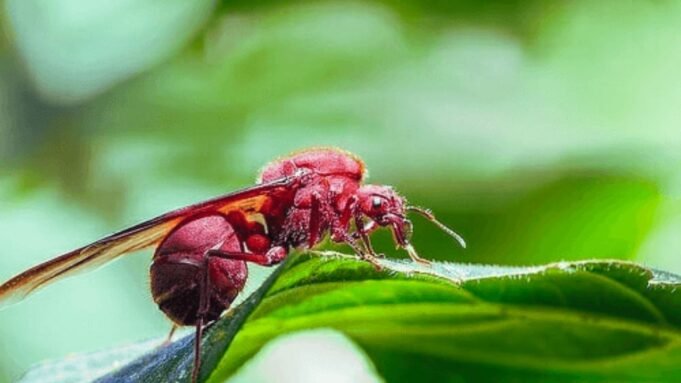In the lush landscapes of Colombia, where biodiversity flourishes, there thrives an unusual delicacy known as the “hormiga culona” or the big-bottomed ant (scientifically known as Atta laevigata).
These ants are a fascinating biological phenomenon and a cherished part of Colombian cultural heritage and cuisine.
Hormiga Culona Biological Characteristics
Atta laevigata is notable for its sizable posterior, which sets it apart from other ant species. These ants are predominantly found in the Santander region of Colombia. They live in complex underground colonies, extending up to several meters in depth.
The lifecycle of these ants is fascinating because of their role as leaf-cutters, contributing significantly to the forest’s ecological balance by decomposing organic material.
Cultural Significance of Hormiga Culona
Historically, hormiga culona has been consumed by indigenous communities for centuries. These ants are often collected, roasted, and eaten during the Holy Week—an annual tradition that marks the beginning of the rainy season when the ants emerge from their nests. For many locals, consuming these ants is believed to be an aphrodisiac and also a symbol of fertility and renewal.
Culinary Uses
The preparation of hormiga culona is straightforward yet labor-intensive. The ants are harvested manually, their wings and pincers removed and then roasted with salt on large pans. They are known for their crunchy texture and a taste that is often likened to peanuts or popcorn. These ants are not only a snack but also used as a gourmet topping on dishes and even incorporated into chocolates and other sweets.
Economic Impact
For the rural economies of Santander, hormiga culona harvesting is a significant annual event that boosts local income. The trade of these ants provides essential revenue for many families, with vendors selling them at markets and roadside stands, and even shipping them across the country and abroad.
Read More: Five of The Best Places to See Animals in The Wild
What Does Hormiga Culona Taste Like?
Hormiga culona, a unique culinary delight from Colombia, offers a flavor profile that surprises many first-time tasters. These large ants, when roasted, develop a crunchy texture that is often likened to crispy fried pork skin or roasted peanuts. The taste is nutty with earthy undertones, sometimes described as a cross between smoked bacon and slightly bitter, roasted nuts.
The roasting process, which involves salting the ants, enhances their natural flavors, making them a savory, protein-rich snack that leaves a memorable and distinctive aftertaste. For those adventurous enough to try them, hormiga culona provides a culinary experience that challenges the palate and broadens the gastronomic horizon.
Where to Try Hormigas Culonas in Colombia?
If you’re eager to sample hormigas culonas, the best places to try this unique Colombian delicacy are in the department of Santander, particularly around the towns of Barichara and San Gil. These areas are known for their traditional methods of preparing the ants, which are often sold in local markets and street stalls, especially during the harvest season in April and May.
Many local restaurants also feature dishes or snacks made with hormigas culonas, providing a truly authentic tasting experience. For a more immersive experience, visitors can participate in food tours that include visits to ant harvesting sites and cooking demonstrations, offering a deeper understanding and appreciation of this traditional culinary practice.
READ: 12 Interesting Facts About Nicaragua
Ethical and Environmental Considerations
While the demand for hormiga culona is beneficial economically, it raises questions about sustainability. The collection methods and the scale of harvest must be managed carefully to avoid disrupting the ant populations and the broader ecosystem. Efforts are underway to regulate the harvest and ensure that it remains a sustainable practice.
Global Interest and Culinary Exports
Internationally, the hormiga culona has piqued the interest of chefs and food enthusiasts who are eager to explore exotic and novel ingredients. This has led to its inclusion in the menus of high-end restaurants worldwide, promoting Colombian culinary culture globally.
Research is ongoing into the potential health benefits of these ants, particularly their high protein content and possible anti-inflammatory properties. There is also interest in cultivating hormiga culona commercially, which could pave the way for sustainable farming practices and new business opportunities.
Conclusion
Hormiga culona offers more than just culinary delight; it embodies the rich biodiversity and cultural tapestry of Colombia. As this unique ingredient makes its way onto the global stage, it carries with it the stories and traditions of the Colombian people, highlighting the importance of maintaining a balance between cultural practices and environmental stewardship.
Read Also: Chicharras
Frequently Asked Questions (FAQs)
What is Hormiga Culona?
Hormiga culona, known scientifically as Atta laevigata, refers to a species of leaf-cutter ants from Colombia, famous for their large size. These ants are a traditional delicacy in the Colombian diet, especially in the Santander region.
Why is Hormiga Culona considered a delicacy?
These ants are considered a delicacy due to their unique taste and the traditional belief in their health benefits, including aphrodisiac properties. They are most commonly consumed roasted with salt, offering a crunchy texture and a nutty flavor.
How are Hormiga Culona harvested?
Hormiga culona are typically harvested at the start of the rainy season when they emerge from their nests. The traditional method involves manually collecting the ants, often at night when they are less active, ensuring the preservation of their nests and colonies.
Are there any health benefits associated with eating Hormiga Culona?
Yes, hormiga culona are high in protein and low in saturated fats, making them a healthier alternative to traditional meat snacks. Some studies suggest that they also contain beneficial fatty acids and other bioactive compounds.
Can Hormiga Culona be found outside of Colombia?
While primarily consumed in Colombia, the global culinary interest has led to the export of hormiga culona to various gourmet markets around the world. They are occasionally available in specialty stores or through online retailers that offer exotic foods.
How should Hormiga Culona be stored?
Once roasted, hormiga culona should be stored in a cool, dry place in an airtight container. This helps maintain their crunchiness and prevents spoilage. Properly stored, they can last for several months.
What dishes can be made with Hormiga Culona?
Besides being eaten as a standalone snack, hormiga culona can be used as a garnish on soups and salads, incorporated into omelets, or even used as a topping on pizzas and pastas for an extra crunch. Some chefs also blend them into sauces for a nutty flavor enhancement.















